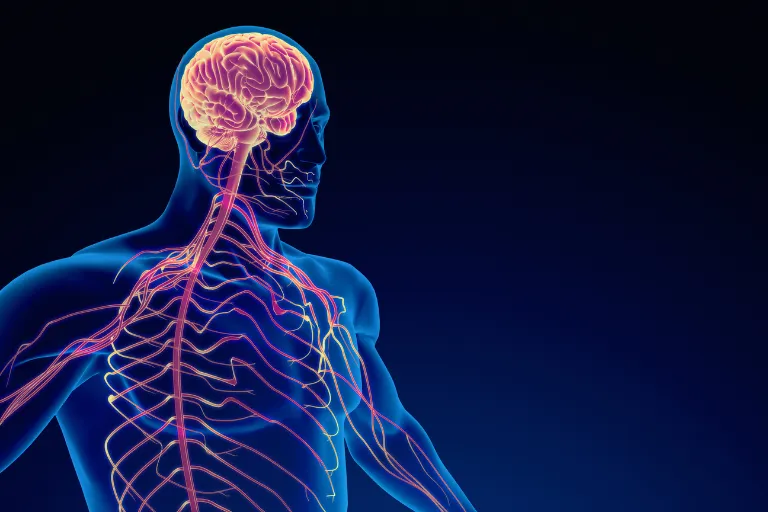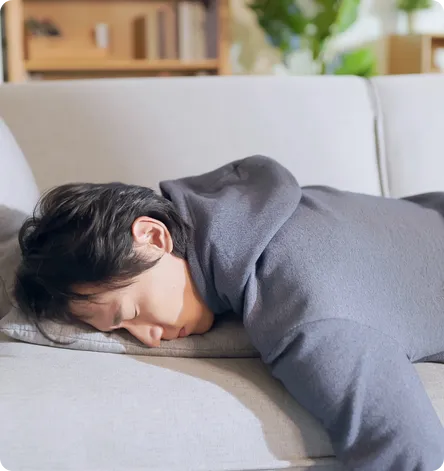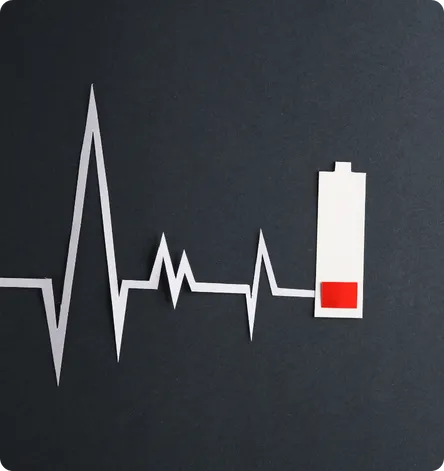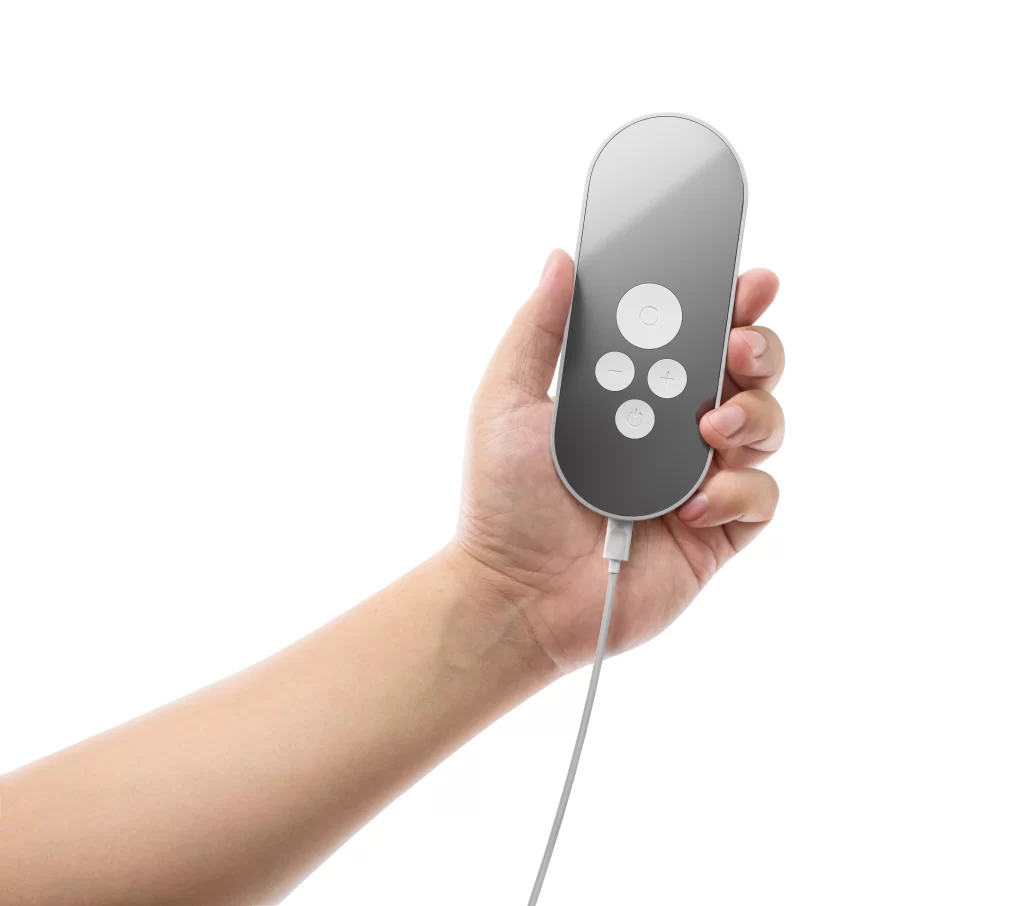And a Simple Daily Reset to Feel Like Yourself Again

You’ve cleaned up your diet. You’ve added supplements. You try to get 7–8 hours of sleep.
And still… something feels off.
- You wake up groggy, like the night never happened.
- You push through the day foggy, irritable, and wired
- Your gut acts up for no clear reason.
- Your watch keeps flashing “low HRV.”
- Even workouts feel heavier than they should.
It’s easy to think these are separate problems.
But more and more research points to a hidden common thread: a dysregulated nervous system.
When your body’s “control pathway” — the network that balances stress and recovery — is stuck in high idle, it quietly throws multiple systems off.
You can sleep, eat, train, and supplement all you want… but until that system can downshift, you stay flat.
Here are seven surprising ways nervous system dysregulation hijacks your health — and how people are beginning to reset it.
#1. Stubborn Fatigue That Rest Doesn’t Fix

You sleep. You rest. You skip the gym.
And yet you wake up unrefreshed — dragging through the morning, bargaining with the alarm.
This isn’t “laziness.” It’s your alert system buzzing between alarms. Your body never fully drops into recovery mode, so even sleep feels shallow.
Micro-reset today: Before bed, try 3 minutes of longer exhales. Inhale softly for 4, exhale for 6. That extra-long exhale is a signal: we can power down now.
#2. Sleep That Looks Long… But Feels Short

Eight hours in bed doesn’t guarantee you’ll feel restored. When your nervous system hovers in overdrive, deep sleep fragments. You clock the hours but miss the depth.
That’s why so many people say, “I sleep but wake up foggy.”
Micro-reset tonight: Set a lights-down time and hold it (weekends included). Dim lights 60 minutes before bed. Step outside for morning light within 30 minutes of waking. These tiny anchors cue your system to sync its clock.
#3. Racing Thoughts & “Stress Autopilot”

Ever notice your mind spinning even on the sofa?
That’s a telltale sign of dysregulation.
Your nervous system is designed to toggle between stress and recovery.
But if the toggle is stuck, thoughts race, muscles stay tense, and calm feels out of reach.
Micro-reset anytime: Two words: nasal breathing. 10 quiet breaths through your nose, slow and low, can drop the volume on that inner static.
#4. Digestion Ups and Downs

Your gut is wired directly to the nervous system. When the control pathway is jammed open, digestion slows or spasms. Heavy meals feel heavier. Random foods “set you off.”
This is why nervous system health shows up as bloating, cramps, or unpredictable digestion.
Micro-reset at meals: For your first five bites, put cutlery down between each. Chew longer than feels normal. This small pause signals safety to your gut.
#5. Low HRV & Flat Recovery Scores

If you track with Oura, Whoop, or Garmin, you’ve probably seen it: your HRV graph flat or stuck low. That’s your recovery capacity blunted.
One triathlete put it perfectly: “I do all the right things — sleep, nutrition, training balance — and my HRV is still flat. Honestly, I don’t get it!!”
What’s happening? The nervous system isn’t switching gears smoothly. The built-in downshift is under-expressed, so your body can’t bounce back.
Micro-reset this week: Insert two 5-minute “buffers” in your workday: stand, sip water, slow exhale, glance out a window. Small signals add up.
#6. Inflammation That Lingers

That low-grade “everything aches” feeling? It’s not in your head. A dysregulated nervous system keeps stress chemistry humming, which in turn keeps inflammation running.
Micro-reset: Draw a caffeine line. Cut it after 2 p.m. Late-day stimulants fuel the buzz that keeps inflammation on.
#7. Brain Fog & Short Fuse

When the nervous system is stuck in alert mode, your working memory shrinks. You start tasks but don’t finish them. You reread the same sentence three times. Your fuse shortens with family or coworkers.
People often describe it as “walking through mud” or “multi-starting instead of multitasking.”
Micro-reset: Try a 20-minute single-task timer. Pick one thing. Close other tabs. Put your phone in another room. Stop when the timer ends. You’re retraining your brain to focus in doable chunks.
The Common Thread: A Control Pathway Stuck in Overdrive
Different symptoms, same lever.
Fatigue. Poor sleep. Gut chaos. Low HRV. Foggy brain. Aches. Anxiety.
All roads point to the control pathway that decides when your body is in stress vs recovery. When it’s stuck in high idle, you can stretch, supplement, and self-care… and still feel flat.
So the real question is: how do you teach your body to downshift — consistently, on purpose, every day?
Meet Nurosym: A Daily Reset for Your Nervous System

Nurosym is a small, non-invasive device designed to support that built-in downshift.
How it works (plain English):
A comfortable clip sits on your ear’s tragus. For 30–60 minutes, Nurosym sends gentle micro-pulses to the auricular branch of the vagus nerve — the pathway your body uses to shift into its calm-and-restore setting.
It’s like gentle physical therapy for your nervous system. You clip in, press start, and go about your day. Read. Plan. Watch a show. No gels. No drugs. No downtime.
What people often notice:
- During sessions: a quieter baseline — like the volume knob turning down.
- In the first weeks: sleep feels deeper; mornings less like a wall.
- With consistency: steadier days, fewer spikes, and a recovery profile that looks more flexible.
Why it’s different:
This isn’t another app reminding you to relax. It targets the control pathway itself — giving your system a physical nudge to recover.
How to Use It (Zero Friction)
- Clip the electrode to your ear (seconds).
- Press start. Adjust until you feel a light, soothing tingle.
- Carry on — emails, reading, winding down.
- Repeat daily. Most start with one 30-minute session; some add a second in the evening.
Habit tip: Pair it with something you already do (morning calendar check, evening chapter). Habits stick when they piggyback.
Picture the Difference in Your Day
- You wake without bargaining with the alarm.
- Coffee becomes a choice, not a crutch.
- Work feels doable — not like a wall.
- That 2 p.m. dip? Softer.
- Dinner lands lighter.
- Evenings aren’t hijacked by racing thoughts.
- And your wearable finally shows what you feel: a more flexible baseline.
That’s the point. Not to chase perfection. To give your body back the capacity it was designed to have.
Your Simple Next Step
- Pick one or two micro-resets from above and try them today.
- Add the daily reset that helps your nervous system practice downshifting: clip in, press start, and let your system learn calm again.
See how Nurosym helps restore balance to the nervous system
Designed and clinically tested in Europe, Nurosym™ delivers gentle, non-invasive stimulation to the vagus nerve — helping the body regain calm, improve autonomic balance, and ease symptoms associated with chronic stress and nervous system dysregulation.
Thousands of users and multiple university-led studies suggest that this simple device may help the body self-regulate more effectively — supporting better sleep, steadier energy, and reduced pain sensitivity.
References
- Chalmers, J. A., Quintana, D. S., Abbott, M. J.-A., & Kemp, A. H. (2014). Anxiety disorders are associated with reduced heart rate variability: A meta-analysis. Frontiers in Psychiatry, 5, 80. https://doi.org/10.3389/fpsyt.2014.00080
- Cattaneo, L. A., Franquillo, A. C., Grecucci, A., Beccia, L., Caretti, V., & Dadomo, H. (2021). Is low heart rate variability associated with emotional dysregulation, psychopathological dimensions and prefrontal dysfunction? An integrative view. Journal of Personalized Medicine, 11(9), 872. https://doi.org/10.3390/jpm11090872
- Geng, D., Liu, X., Wang, Y., & Wang, J. (2022). The effect of transcutaneous auricular vagus nerve stimulation on HRV in healthy young people. PLOS ONE, 17(2), e0263833. https://doi.org/10.1371/journal.pone.0263833
- Kim, A. Y., Marduy, A., de Melo, P. S., Gianlorenco, A. C., Kim, C. K., Choi, H., … Fregni, F. (2022). Safety of transcutaneous auricular vagus nerve stimulation (taVNS): A systematic review and meta-analysis. Scientific Reports, 12, 22055. https://doi.org/10.1038/s41598-022-25864-1
- Redgrave, J., Day, D., Leung, H., Laud, P. J., Ali, A., Lindert, R., & Majid, A. (2018). Safety and tolerability of transcutaneous vagus nerve stimulation in humans; A systematic review. Brain Stimulation, 11(3), 512–519. https://doi.org/10.1016/j.brs.2018.08.010
- Stavrakis, S., Elkholey, K., Morris, L., Niewiadomska, M., Asad, Z. U. A., Humphrey, M. B., … Po, S. S. (2022). Neuromodulation of inflammation to treat heart failure with preserved ejection fraction: A pilot randomized clinical trial. Journal of the American Heart Association, 11(3), e023582. https://doi.org/10.1161/JAHA.121.023582
- Tracey, K. J. (2002). The inflammatory reflex. Nature, 420(6917), 853–859. https://doi.org/10.1038/nature01321
- Tracey, K. J. (2009). Reflex control of immunity. Nature Reviews Immunology, 9(6), 418–428. https://doi.org/10.1038/nri2566
- Tarn, J., Legg, S., Mitchell, S., Simon, B., Ng, W.-F., & Sleath, M. (2019). The effects of noninvasive vagus nerve stimulation on fatigue and immune responses in primary Sjögren’s syndrome. Neuromodulation, 22(5), 580–585. https://doi.org/10.1111/ner.12879
- Tarn, J., Legg, S., Mitchell, S., Simon, B., Ng, W.-F., & Sleath, M. (2023). Non-invasive vagus nerve stimulation (nVNS) for primary Sjögren’s syndrome: A randomized double-blind feasibility study. Neuromodulation, 26(3), 681–689. https://doi.org/10.1016/j.neurom.2022.08.461
- Zhang, S., Zhao, Y., Qin, Z., Chen, Y., Tu, C., Zhang, X., et al. (2024). Transcutaneous auricular vagus nerve stimulation for chronic insomnia disorder: A randomized clinical trial. JAMA Network Open, 7(12), e2451217. https://doi.org/10.1001/jamanetworkopen.2024.51217
- Gianlorenço, A. C., de Melo, P. S., Gianlorenço, K. P.-B., Pereira, L., Choi, H., Song, J.-J., & Fregni, F. (2024). Age as an effect modifier of transcutaneous auricular vagus nerve stimulation (taVNS) on heart rate variability in healthy subjects. Journal of Clinical Medicine, 13(14), 4267. https://doi.org/10.3390/jcm13144267
The article does not in any way constitute as medical advice. Please seek consultation with a licensed medical professional before starting any treatment. This website may receive commissions from the links or products mentioned in this article.
Share via:



